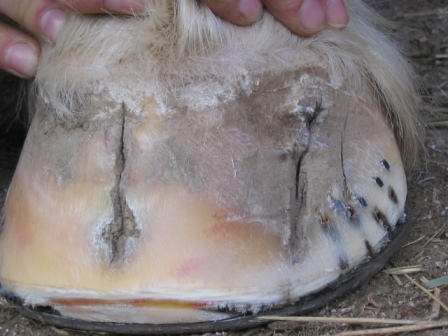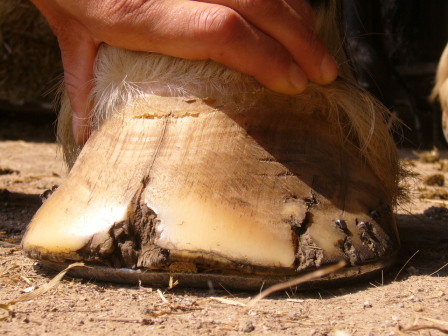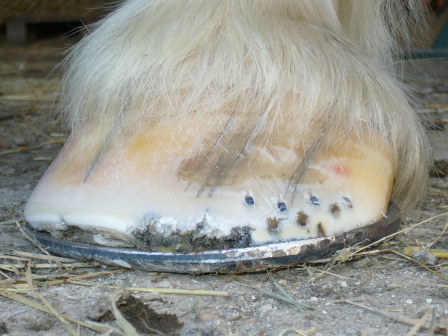Beckie’s Equine Letter
News, Case Studies, Questions & Answers
and a Lesson of the Month in every Issue
Winter 2007 — Issue 13
News for the Month
Happy New year to you all. Hope you all had a lovely Christmas and thank you for all of my lovely cards and gifts. I felt quite overwhelmed with how generous you all are. I don’t like just receiving gifts and not reciprocating with giving but I’m afraid to treat you all equally I can’t quite stretch to a gift each. :-) But thank you very much.
I had a lovely week off over Christmas which is definitely going to become an annual tradition. Thank you for holding back on phoning me with problems during the Christmas week, it really did give me a chance to relax.
Talking about time off Ben and I are going away for a weeks holiday in February from the 3rd - 10th. Ross Eager will be covering any emergencies for me during this time. His number will be on my answer phone should you have any problems.
I’m also lucky enough to have the chance to return to Colorado in April for another shoeing course. This time the focus is on becoming an Advanced Lameness Specialist! I am really looking forward to it. Such a great opportunity that will inevitably help with the shoeing of all of your horses.
During the later part of 2006 I attended a few of Anvil Vet’s talks for horse owners. These ranged from Equine Veterinary Herpes (EVH), Stomach Ulcers, and a really up to date multi-media presentation on the lower limb. Although they were all excellent talks the lower limb one caught my attention the most. I was also able to get involved fending off the questions at the end, which seemed to mainly be farrier related.
The start of 2007 is an exciting time for me as a predominantly Natural Balance Farrier. There is another great shoe that’s out called the Centre Fit Shoe. It is based on the Natural Balance Shoe, but the edges of the shoe are even more beveled off to make it even easier for the horse to turn. I’ll be trying these shoes out over the next few months to see if you can notice a difference. All these subtle changes to the shoe will help to prevent ligament and tendon problems, or to ease already damaged limbs.
Well I have given this Newsletter a bit of a theme, with most of the content relating to different types of hoof cracks. The main reason we struggle so much with cracking hoofs in this country is to do with our wet climate. We turf the horses out in wet muddy fields, let their feet get saturated, then put them straight into a dry bed. The feet find it very hard to cope with the ever changing wet and dry conditions. The simplest way I think I can describe it is when a flood plain goes from wet to dry it forms cracks. When the feet are wet they are softer, making it easy for dirt to work its way in. Read on to find out more.
Lesson of the Month
Hoof Cracks
Definition
There are three types of crack:
Grass Crack - Runs from the ground up.
Sand Crack - Runs from the coronary band down.
Horizontal Crack - Runs across the foot
There are four other ways of describing a crack:
Complicated - It has run deep enough to involve the sensitive structures.
Un-complicated - It is more superficial and the sensitive structures aren’t affected.
Complete - It runs the whole length of the hoof from top to bottom.
In-Complete - It doesn’t run the full length of the hoof.
So the worst crack is a Complicated Complete crack. Any crack that involves the sensitive tissues requires veterinary attention. Refer to the separate sheet for examples of different cracks
Causes
Overgrown feet, direct trauma, foot imbalance, abscess, seedy toe, nutritional imbalance, conformational abnormalities, environment, foot mutilation by the farrier or as a result of Laminitis.
Treatments
Firstly establish if the sensitive tissues are involved and whether a vet is needed. Try and obtain the cause of the crack. Trim the feet cleaning away any necrotic tissue around the crack. This is essential as often these flaps of horn hold in all the bacteria so it continues to eat away at the healthy horn. I find with un-complicated cracks filling the cavity with Keratex hoof putty and some Venice Turpentine encourages the crack to grow out and prevents more dirt getting in. With more serious cracks you might need to stabilise the crack with a crack patch, staples or glue for example.
There are many methods for stabilising cracks. Here are a few below. (Fig 1: a crack patch screwed into the foot. Fig 2:
a clip screwed and glued to the foot to hold it together. Fig 3: a patch screwed on with about 20 screws and covered with glue.)
Fig 1

Fig 2
Fig 3

Case Study
Lindsay Barnes – William
Following on from the Lesson of the Month and the theme of cracks, I am going to share with you Williams Story. William is a Shire X Thoroughbred, owned by Lindsay Barnes in Lancing. He was unfortunate because the thoroughbred in him shows in his feet. He is a heavy horse to be stood on such delicate feet.
Williams problems all started in October 2005 when he changed yards, moved away from his mum (Dolly) and started doing a lot more hacking on the flinty South Downs. We haven’t got confirmed reasons for the coming events with Williams feet, but are suspicious that all these things contributed. Very wet conditions of the field, possibly a fertiliser that was used on the grass and an increase in work load on rough flinty terrain.
In October 2005 both of Williams front feet developed two splits in the coronary band. It looked liked an abscess had blown out. It was red, split and oozing. If there was just one split I would have thought it were the result of an abscess but not FOUR! He was never lame with this but I could see what was going to happen. The horny hoof grows down from the coronary band so this defect was going to be with us for at least a year or until he re-grows a whole new hoof. Over the coming months cracks grew down from all four splits at the coronary band. 8 months down the line in June these cracks reached the bottom and this was the point in which they looked the worst. It looked like he had cloven feet! I felt for Lindsay because everyone on the yard was commenting about his bad feet, yet Lindsay was doing everything she could to help the healing process along. And so was I :-)
Well a year on, October 2006 you can see that the crack did join up at the bottom. William remains to be sound. Unfortunately it is still a bit of a mystery what caused it, but we are so pleased it is getting better.
Oct 05

Jan 06


Oct 06

Questions and Answers
Q. Wouldn’t fitting a toe clip help a crack at the toe?
A. If bacteria has already penetrated the hoof, by fitting a toe clip you are just stopping the air from getting to the crack. The bacteria can only breed in an-aerobic conditions, (where the air can’t get to it) so in my experience this just makes it worse. It just stores all the gremlins in there.
Q. Is Keratex hoof hardener a good thing to paint onto cracks?
A. Yes Keratex is very good at killing all kinds of bacteria. It can also be used as a precautionary measure to harden up the feet. All it takes is something as small as a grain of sand to penetrated to cause an infection. When the feet get over saturated foreign bodies are more likely to work their way into the soft feet.
Feedback
This issues feedback is written by Debbie Smith who owns Friday, a 7 year old X-Racehorse. To give you some history of Friday, when I first saw her she was pretty lame just in walk with a suppurated corn, meaning an infection in the seat of corn (heal region) with pus coming out of it. She had a smaller corn on the other front foot too. She wasn’t shod badly at all, but in my opinion the feet were quite long. Debbie was shocked because her previous farrier hadn’t ever trimmed any foot off. Debbie was lead to believe that Friday never grew any foot and had the worst feet on his books, and she should just expect a life time of foot problems. Friday was being shod every 4 weeks because her shoes regularly fell off, and she was on and off lame for the two years Debbie’s had her.
I began shoeing Friday in June 2006, to me it was quite a standard shoeing on a good footed thoroughbred. She had a good amount of foot to trim off. They were quite off balance, which was adding to the cause of the corns. The toes were quite long. But all in all just standard tweaks that I’d expect to make on the first shoeing of any new horse. Friday is now shod every 6 weeks, touch wood she doesn’t lose shoes, and more importantly she is sound and Debbie can ride her straight after the shoeing. This is what Debbie had to say...
“I’m so pleased with how Friday now goes. It is such a weight off my mind. She now doesn’t lose shoes, I can ride her straight after shoeing and her feet are a much better shape. The clenches used to rise after about 3 weeks and cause her to cut her opposite legs. It’s amazing she’s now done every 6 weeks and the clenches are as tight as they were just after she was done. My attention can now be on enjoying my horse rather than worrying what problems going to occur next.”
Debbie Smith
Before

After

Handouts that went with this Newsletter

